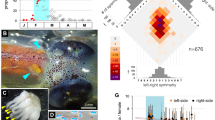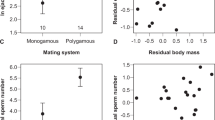Abstract
THE opisthobranch gastropod Aplysia is a simultaneous hermaphrodite with internal fertilisation. The functional morphology of the reproductive system1–4 has been well studied and oviposition is known to be under some hormonal control5–7. Adults may assume the role of sperm donor or recipient, or both at the same time. Recent discussions of the evolutionary significance of simultaneous hermaphroditism2,8–14 as well as considerations of the relative roles of sperm donors and recipients in selecting partners15,16, have suggested that Aplysia offers an opportunity to investigate the processes involved in the assumption of different sex roles in the same animal. Accordingly we analysed data collected several years ago during other field studies of Aplysia dactylomela17,18. We found that most animals were as likely to be sperm donors as recipients during different copulations, and there was a significant relationship between frequency of copulation and number of different partners in the total population studied. A few individuals, however, were found to copulate with fewer partners than sperm recipients.
This is a preview of subscription content, access via your institution
Access options
Subscribe to this journal
Receive 51 print issues and online access
$199.00 per year
only $3.90 per issue
Buy this article
- Purchase on Springer Link
- Instant access to full article PDF
Prices may be subject to local taxes which are calculated during checkout
Similar content being viewed by others
References
Bebbington, A. & Thompson, T. E. Malacology 9, 253 (1969).
Ghiselin, M. T. Malacology 3, 327–378 (1965).
Thompson, T. E. The Biology of Opisthobranch Molluscs (Ray Society, London, 1976).
Thompson, T. E. & Bebbington, A. Malacology 7, 347–380 (1969).
Arch, S. & Smock, T. Behav. Biol. 19, 45–54 (1977).
Kupfermann, I. J. Neurophysiol. 33, 877–881 (1970).
Coggeshall, R. E. Am. Zool. 12, 521–523 (1972).
Ghiselin, M. T. Q. Rev. Biol. 44, 189–208 (1969).
Williams, G. C. Sex and Evolution (Princeton University Press, 1975).
Williams, G. C. & Mitton, J. B. J. theoret. Biol. 39, 545–554 (1973).
Charnov, E. L. & Bull, J. Nature 266, 828–830 (1977).
Maynard Smith, J. in Group Selection (ed. Williams, G. C.) (Aldine-Atherton, Chicago, 1971).
Ghiselin, M. T. Nature 258, 32 (1975).
Charnov, E. L., Maynard Smith, J. & Bull, J. Nature 263, 125–126 (1976).
Zahavi, A. J. theoret. Biol. 53, 205–214 (1975).
Smith, J. M. J. theoret. Biol. 57, 239–243 (1976).
Tobach, E., Gold, P. & Zeigler, A. Veliger 8, 16–18 (1965).
Lederhendler, I., Bell, I. & Tobach, E. Veliger 17, 347–353 (1975).
Siegel, S. Nonparametric Statistics (McGraw-Hill, New York, 1956).
Hunt, Jr G. L. & Hunt, M. W. Science 196, 1466–1467 (1977).
Parker, G. A. Biol. Rev. 45, 525–567 (1970).
Author information
Authors and Affiliations
Rights and permissions
About this article
Cite this article
LEDERHENDLER, I., TOBACH, E. Reproductive roles in the simultaneous hermaphrodite Aplysia dactylomela. Nature 270, 238–239 (1977). https://doi.org/10.1038/270238a0
Received:
Accepted:
Issue Date:
DOI: https://doi.org/10.1038/270238a0
Comments
By submitting a comment you agree to abide by our Terms and Community Guidelines. If you find something abusive or that does not comply with our terms or guidelines please flag it as inappropriate.



